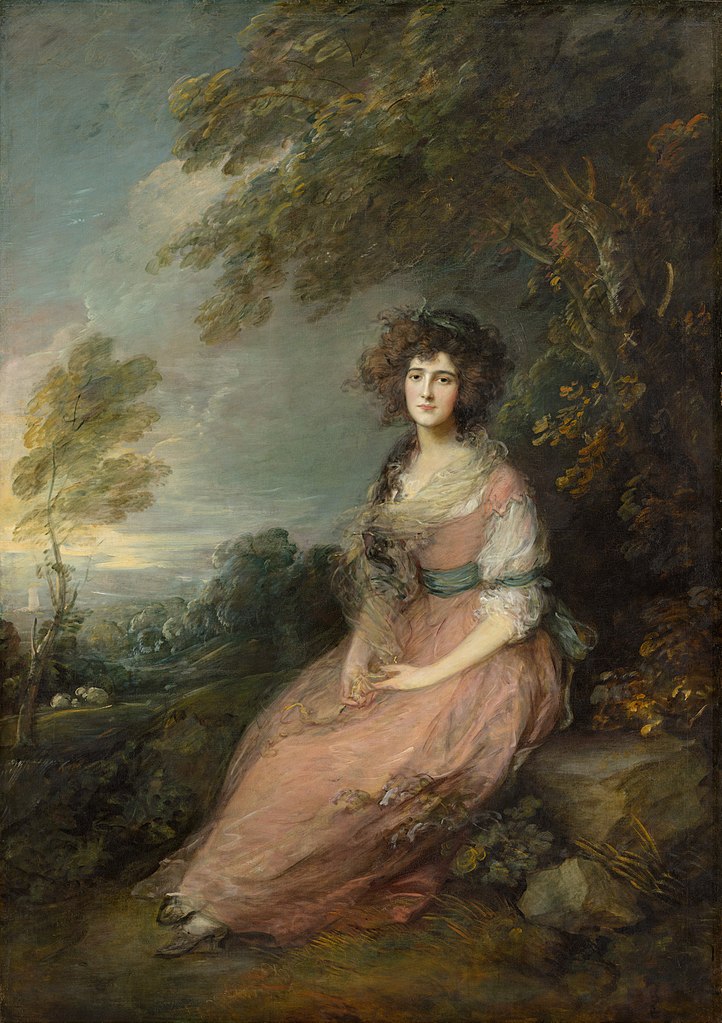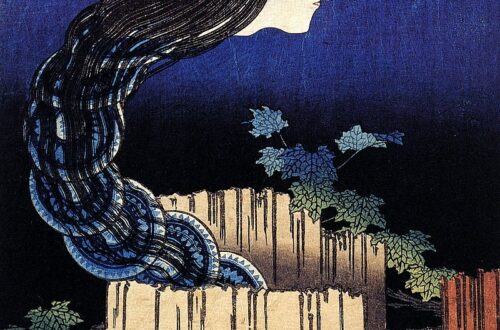
Thomas Gainsborough
Thomas Gainsborough was born on the 14th May 1727 and was one of the most important British artists in the second half of the 18th century. He was one of the founding members of the Royal Academy of Arts in 1769 but the relationship to the Royal Academy was not the best and he stopped sending his paintings to the Academy’s exhibitions in 1773. He was widely known for his portraits and indeed one of the most sought-after portrait painters of his time. He was always in competition with the then more famous Sir Joshua Reynolds whose paintings were a bit more conservative and less experimental than Gainsborough’s works. Gainsborough usually worked fast, he executed a more painterly style than his contemporary painters, he liked to experiment and he despised – of all things! – portrait painting. In the 1960 he wrote:
„I’m sick of Portraits and wish very much to take my Viola da Gamba and walk off to some sweet Village where I can paint Landskips [landscapes] and enjoy the fag End of Life in quietness and ease“. [1]

He often disliked the people whom he had to portray:
… damn Gentlemen, there is not such a set of Enemies to a real artist in the world as they are, if not kept at a proper distance. They think … that they reward your merit by their Company & notice; but I … know that they have but one part worth looking at, and that is their Purse; their Hearts are seldom near enough the right place to get a sight of it.[2]
Despite his anthipathy: Portrait work was the work that put bread on the table. But in the end he found a way to found a way to combine his enthusiasm for landscape painting and paid portrait works by painting his clients in the midst of landscapes.
Without further ado and like his french colleagues Jean-Honoré Fragonard and Jean-Antoine Watteau he placed his sitters in the middle of natural landscapes. Although the landscapes with the sitters look perfectly natural and spontaneous he did not paint them outside. Plein air, painting outside, was uncommon at that time. Instead, the painters, including Gainsborough, usually did their sketches outside and painted their pictures afterwards in the studio with their sketches as reference. They had to rely on their memory and some tricks: To create the Chiaroscuro — the play of light and shadows — more convincingly, Gainsborough to paint his portraits at night in the flickering light of candles. To help his memory of the landscapes he used to built little landscapes from cork, coal, moss, mirrors, lichens, sand, and used broccoli in the front as stand-in for trees. So when welsh landscape painter Richard Wilson described Gainsborough’s trees and foliage as “fried parsley” he was more accurate than he knew.

One of the loveliest portraits he painted was the one of Mrs Richard – Elizabeth Ann – Brinsley Sheridan, née Linley (1754-1792). She was the most noted soprano singer of her days and also a very talented writer, and poet. 1772 she married the Irish politician and playwright Richard Brinsley Sheridan. The circumstances that preceded the marriage were dramatic and could have been part of an exciting novel: In 1772, before Elizabeth Ann and the young Richard became married, some Captain Thomas Mathews wrote a defaming newspaper article about the future Mrs. Brinsley Sheridan’s character.
Richard Brinsley Sheridan who intended to marry the beautiful young singer challenged Mr. Mathews to a duel. The first duel, in Henrietta Street (Covent Garden) was short and bloodless, with Mathews as loser. Mathews was forced to write a public apology, felt humiliated and challenged Sheridan again. Both participants therefore agreed to meet a second time. They met in July 1772 near Bath. This time both men broke their swords but carried on fighting in a „desperate struggle for life and honour“. Both men were wounded, Sheridan quite dangerously. Mathews escaped, Sheridan recovered. The young couple eloped and returned to London where they set up house with help of Elizabeth Ann’s Dowry – Sheridan was penniless before they married.

Late 1760s,
oil on canvas, 76,5 cm (30.11 in) x 63,5 cm (25 in), Dulwich Picture Gallery
With all the drama preceeding the marriage it should have been a a fairy-tale “happily ever after”-ending. If it was a novel it would have been. But, alas, it was real life and the marriage quickly turned sour. No wonder: He forbade her to continue her career as singer because it was not „appropriate“ in his eyes. He took most of her dowry, leaving her with very meagre pocket money, to buy a house and piling up debts to support his lavish lifestyle. She was also a talented writer — a fact that Linley capitalized upon by abandoning his law career and becoming a freelance writer with the help of his wife. As many men in history he built his career on her back, taking credit for her work and leaving her to do all the thankless and annoying jobs.
In other areas of their life were completely incompatible either: He preferred the buzzing city life, she wanted to live in the countryside. They both had extramarital affairs. After many miscarriages she finally succumbed to tuberculosis when she was only 37.

Gainsborough was friends with the Linley-family and he created several portraits of the family, one of which is this portrait. The beautiful Mrs. Sheridan was the ideal model for Gainsborough. She basically was the epitome of a romantic heroine, trapped in an unhappy marriage and fellow nature lover. She even begged her husband to
„Take me out of the whirl of the world, place me in the quiet and simple scenes of life I was born for.“[3]
The exquisitely executed painting shows the young woman as full-figure in a light pink gown, surrounded by nature. The portrait captures the model’s charming personality and her melancholy; her sad face is the only part of the painting that is calm and solid, the rest of the painting shows much more movement due to the short, sketch-like brush strokes. The paint has a nearly translucent, shimmering quality: Gainsborough often used very thin oil paint, applied it in layers and the effect resembles a watercolour effect, creating depth and a very delicate impression. As in many of his portraits he was able to capture the essence of his sitter’s delicate character, her soft nature and her sadness.
This portrait already shows some of the traits of the upcoming era of romanticism: pastoral surroundings, nature, melancholy, muted colours.
——————————–
[1] Letter to William Jackson, from Bath, dated 4 June (but without the year), in M. Woodall (ed.), The Letters of Thomas Gainsborough (London, 1961), p. 115.
[2] Letter to William Jackson, from Bath, dated 2 September 1767, in M. Woodall (ed.), The Letters of Thomas Gainsborough (London, 1961), p. 101.
[3] British and American Grand Manner Portraits of the 1700s, National Gallery of Art, archived from the original on 4 December 2014, retrieved 30 November 2014



